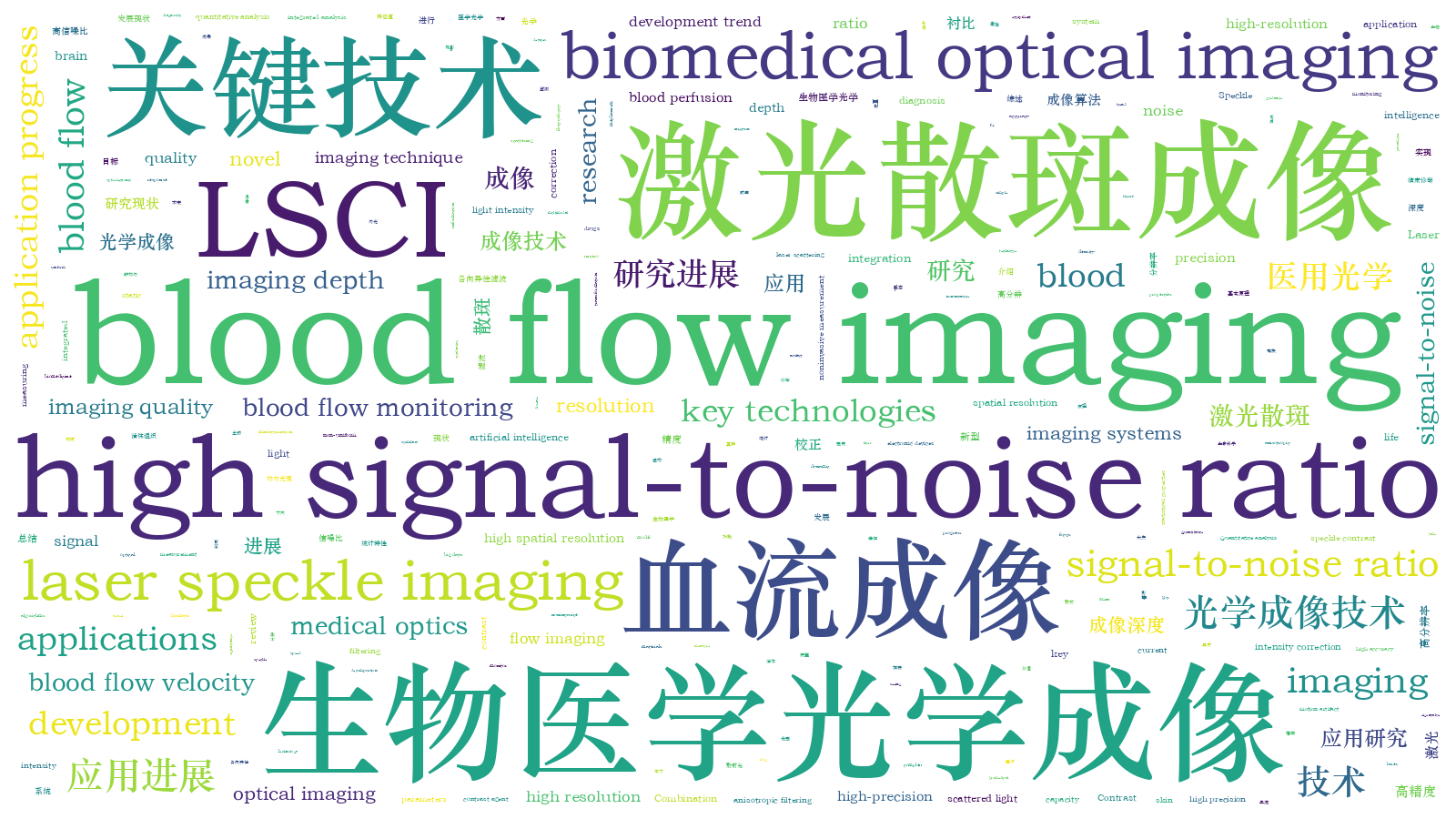激光散斑衬比血流成像关键技术及应用研究进展  下载: 1220次
下载: 1220次
Blood flow is an important parameter for measuring vital signs, and hemodynamic parameters are functional indicators of the microcirculatory system of the skin, brain, heart, liver, kidneys, and other organs. Therefore, dynamic blood flow monitoring has important application value and significance in clinical and basic life science fields, such as clinical diagnosis, intraoperative guidance, drug research, disease mechanism research, and neuroscience. Laser speckle contrast imaging (LSCI) is a full-field optical imaging technique that uses the spatial and temporal statistical properties of laser scattering intensity to monitor the blood flow of tissues in vivo. It uses simple equipment, is non-invasive, and has a fast imaging speed and high spatial resolution. Additionally, it does not require the injection of a contrast agent and can perform continuous measures for a long time. Consequently, it is widely used to measure microcirculatory blood flow parameters such as the vessel diameter, blood flow velocity, blood perfusion, and blood density in tissues and organs. It also can help doctors locate the lesion precisely with clear and accurate blood flow data,and then analyze the corresponding functional response and pathological mechanisms, which has become one of the most important tools for the clinical diagnosis of fundus diseases, skin diseases, brain diseases, and so on. In addition, it is also an important tool for basic life science research in drugs, cardiovascular and cerebrovascular diseases, and brain cognitive and behavioral sciences. Consequently, in-depth research on novel LSCI techniques with high imaging quality is valuable and significant for improving the quality of medical care and promoting the development of basic research in life science.
In the past decades, many researchers have conducted extensive researches on how to improve the quality of LSCI and expand the scope of LSCI applications, and they have had positive progress. For example, a few research groups like Luo Qingming and Li Pengcheng at Huazhong University of Science and Technology, and Tong Shanbao at Shanghai Jiao Tong University have worked on portable LSCI systems, high signal-to-noise ratio LSCI, and high resolution LSCI, which have promoted the development of LSCI in China. Researchers abroad like Boas at Boston University, Zakharov at the University of Fribourg, and Dunn at the University of Texas at Austin have worked on high-precision imaging using LSCI techniques, such as static scattered light correction and quantitative analysis of LSCI, which has also greatly promoted the development of key techniques and novel LSCI applications.
In this paper, we presented a systematic, comprehensive and integrated analysis, review and summary of the current researches about key techniques and applications of novel LSCI at home and abroad emphatically from the aspect of high signal-to-noise ratio LSCI, high-resolution LSCI, high-precision LSCI, large imaging depth LSCI, and novel LSCI systems based on the investigations of current literature. In this way, we can help researchers learn more about the frontier technologies of LSCI and understand the technical challenges we faced, and we can provide ideas with a reference value to promote the development of high-quality, highly practical, and innovative LSCI systems to meet the needs of clinical diagnosis and basic biomedical research. The review consisted of the following contents: First, the technical problems of measuring deep blood flow and achieving high resolution, high signal-to-noise ratio, and high precision have been systematically summarized, and the corresponding solutions are indicated. Subsequently, we review high signal-to-noise ratio LSCI techniques based on anisotropic filtering, eigenvalue-decomposition, and transformation domain collaborative filtering methods. Meanwhile, high-resolution LSCI for motion artifact, out-of-focus blur, and non-uniform light intensity correction are also summarized. Third, we elaborate the high-precision LSCI from the perspective of static scattered light correction, quantitative analysis, and novel LSCI algorithms. After summarizing the LSCI with a large imaging depth, we introduce the latest research on the novel LSCI system and its applications in the fields of cortical blood flow imaging, surgical and therapeutic procedures, and brain and cognitive-behavioral sciences. Finally, we discuss and look forward to the development of LSCI in the future.
In conclusion, LSCI has made qualitative leaps and developments in theory, imaging systems, computational methods, and clinical applications. The imaging quality of LSCI has been developed to have a high signal-to-noise ratio, high resolution, high accuracy, and large imaging depth. However, as the application scenarios of LSCI become more and more complex, which introduces greater challenges to the development of key techniques and application of LSCI. In the future, LSCI will be deeply integrated with emerging interdisciplinary fields such as biomedicine, optoelectronic information, artificial intelligence, and big data. In addition, new breakthroughs are expected in the following respects. (1) Quantitative analysis capacity. The capacity is still an important fundamental issue for LSCI in functional applications. (2) Combination of LSCI with new endoscopic technology (this will enable the noninvasive measurement of blood flow). (3) Miniaturization and integration. The development of new materials and electronic devices will certainly promote the miniaturization and integration of new LSCI systems. (4) Combination of LSCI with artificial intelligence. Artificial intelligence will further promote the development of LSCI technologies and their applications. (5) Combination with other imaging modalities (this will build a new model for LSCI-based multimodal clinical diagnostic applications). It is believed that LSCI will show a synergistic development trend in the future. We look forward to seeing the development of technologies and applications of LSCI.
翟林君, 傅玉青, 杜永兆. 激光散斑衬比血流成像关键技术及应用研究进展[J]. 中国激光, 2023, 50(9): 0907106. Linjun Zhai, Yuqing Fu, Yongzhao Du. Advances in Laser Speckle Contrast Imaging: Key Techniques and Applications[J]. Chinese Journal of Lasers, 2023, 50(9): 0907106.







